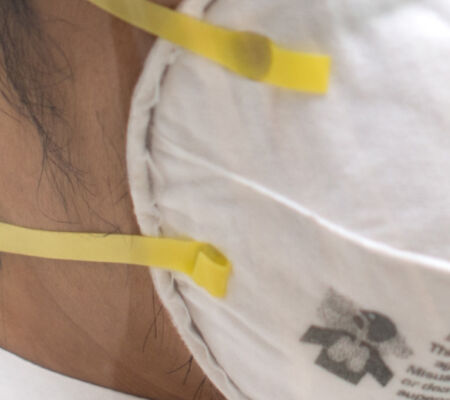
The Physiological and Psychological Impacts of N95 Use
Back to Articles & Resources View all Healthcare & Life Sciences content
Respirator use is on the rise and this is likely to continue to be a common sight for some time to come. In many workplaces that require close contact with people such as doctors, nurses, dentists, physiotherapists, beauticians and aged care facility workers, the risk of airborne transmission of infections is increased. In these settings N95s are one of the most common forms of respiratory protection being used, and although they are effective at limiting exposure risks, there are some significant physiological and psychological concerns being raised by those using them. One of the most common experiences that is being reported is fatigue and understanding the implications of this is incredibly important in ensuring both the user’s welfare and those they are working with.
In order for an N95 to be effective, they rely on the seal along the user's face which creates negative pressure when the user breathes in. If fitted properly, up to 95% of particulates and airborne contaminants are prevented from entering the user’s respiratory system. However it’s this process that is causing discomfort and fatigue for the user as they overexert energy in order to breathe. A study has found that during cardiopulmonary resuscitation (CPR) while wearing N95s the rescuers chest compression rate, depth and complete chest recoil are significantly reduced. This indicates that N95s can be an issue causing fatigue and being unable to provide the appropriate level of medical care in these instances can have detrimental effects on survival rates of patients.
One of the common complaints when using an N95 is the feeling of air being restricted when breathing in and out. An assessment of breathing resistance measuring nasal airflow resistance found that the participants wearing the N95s experienced on average a reduction of 37% in air exchange volume when compared to the non-respirator wearing group. This supports the anecdotal evidence of why there is breathing discomfort and fatigue increased for those in roles where respiratory protection is required. Similarly breathing resistance was found in a study of cardiopulmonary exercise capacity when wearing N95s with healthy participants. This is consistent with the evidence that N95s can impact on occupational activities, and where performance is crucial to life, having a fatigued workforce can have a negative impact.
Aside from the obvious physiological impact of N95s on breathing, there are other health implications that have a negative effect on the wearer. These can include lightheadedness, dizziness, nausea, headaches, tiredness, overheating, acne, and skin irritations/burns/bruising. All of these add to a feeling of discomfort and can increase our levels of stress and anxiety in already challenging working environments. Although N95s are designed to protect the wearer, they can increase the need for breaks in order to oxygenate, regain energy and to be mentally prepared to face the challenges in your role again. As fatigue affects you during your day, this can have negative effects on your personal life also, as you spend more time recovering so you have enough energy for when you get back to work than enjoying life outside of work. In a time where there are concerns for people’s mental health, it is vital that everything possible is being done in order to make people safe and comfortable in their workplaces to support them in trying times.
As wearing N95s covers a large proportion of your face, this limits the ability to communicate effectively through non-verbal communication and this can create a huge barrier in any role, no matter the occupation. To combat the loss of comprehension this causes the mask wearer to increase the volume at which they speak in an attempt for the person on the receiving end to understand them. What this does is tire their voice and in that act, can produce more heat inside the respirator. As there is more heat and moisture produced from breathing inside the N95 this can both reduce the efficacy of the respirator and clog the mask, causing breathing to become more difficult. As the user gets tired quicker, this can negatively impact their ability to safely fulfil their roles.
People have grown tired of these effects, and other forms of respiratory protection have since become utilized in these settings. One of the most common types is the powered air purifier with loose-fitting respirator. These operate by a battery powered fan drawing in ambient air that passes through a filter which is then sent to the users breathing zone. The air being supplied to the headtop creates a positive pressure environment which allows the user to breathe as they normally would. In addition, the air that is being supplied to the user can also provide some cooling which can help to alleviate feelings of tiredness and fatigue.
Although N95s have their place in certain settings as single use, disposable respirators that are designed to be worn for short periods of time in low level risk environments, it’s clear they have a large range of negative implications for both the user and those around them. When people’s physical and emotional wellbeing is at stake, it’s important to explore other options that are going to support them making a real difference, and one way is through the use of loose-fitting respirators.
Works Cited
Fikenzer et al. (2020, July 6). Effects of surgical and FFP2/N95 face masks on cardiopulmonary exercise capacity. Retrieved from Springer Nature: https://link.springer.com/arti...
Lee H, P & Wang, D, Y. (2011, September 5). Objective Assessment of Increase in Breathing Resistance of N95 Respirators on Human Subjects. Retrieved from Oxford Academic: https://academic.oup.com/annwe...
Tian et al. (2020, May 18). Wearing a N95 mask increases rescuer's fatigue and decreases chest compression quality in simulated cardiopulmonary resuscitation. Retrieved from National Center for Biotechnology Information: https://www.ncbi.nlm.nih.gov/p...
